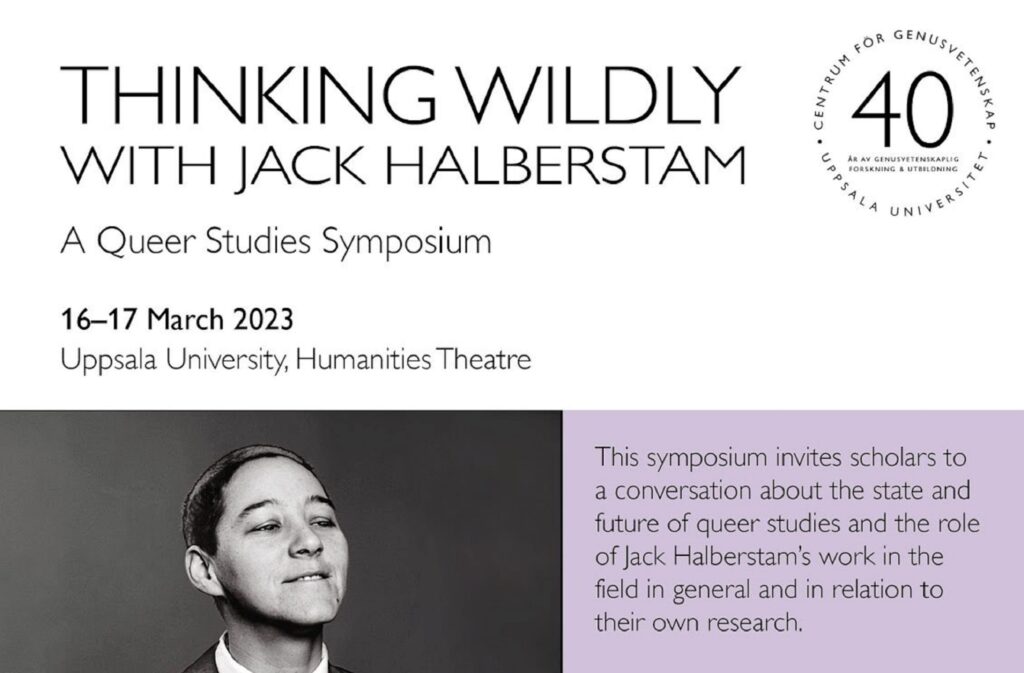In March I had the opportunity to travel to Uppsala, a tiny university town close to Stockholm (Sweden), to meet Queer Theory luminary Jack Halberstam. Uppsala University’s Center for Gender Studies had in fact organized a Queer Studies symposium titled Thinking Wildly with Jack Halberstam. But who is Jack Halberstam? And how can one think wildly?
Halberstam, PhD, currently works as a Professor in the Department of English and Comparative Literature and the Institute for Research on Women, Gender, and Sexuality at Columbia University. Regarding his own pronouns and identity, Jack (also known as Judith and Jude) Halberstam wrote: “When it comes to names and pronouns, I am a bit of a free floater. […] The back and forth between he and she sort of captures the form that my gender takes nowadays. […] I think my floating gender pronouns capture well the refusal to resolve my gender ambiguity that has become a kind of identity for me. […] I prefer not to transition. I prefer not to clarify what must categorically remain murky. I prefer not to help people out in their gender quandaries and yet, I appreciate you asking. […] So, if you are wondering about my pronoun use and would like it resolved once and for all, I cannot help you there. […] Consider my gender improvised at best, uncertain and mispronounced more often than not, irresolvable and ever-shifting.”
Throughout her career as a scholar, writer, theorist, and philosopher, Halberstam has advocated for queer feminism – explicitly using feminist and queer theories together, and ‘queering’ feminism through challenging compulsory heterosexuality and the gender binary – and recognized the need to “move far beyond the limited scope of white gay male concerns and interests.” His main contributions to Queer Theory include diverse topics such as female masculinity, tomboys, and drag kings; queer temporality; queer failure; Gaga feminism. Let’s explain some of them more in detail.
Despite it being her third book, Female Masculinity (1998) can be considered Halberstam’s breakthrough work. Here, Halberstam tries to detangle masculinity and femininity from their presumed ‘biological bases’. The book re-reads popular TV products and films (such as 1953 Calamity Jane) through queer lenses, allowing the reader to ‘see’ queerness even where it is not explicitly shown. Halberstam concludes: “[F]ar from being an imitation of maleness, female masculinity actually affords us a glimpse of how masculinity is constructed as masculinity.”
The concept of queer temporality (explored by Halberstam in In a Queer Time and Place: Transgender Bodies, Subcultural Lives, 2005) opposes chrononormativity, which is the heteronormative temporal notion that a ‘good’, ‘happy’, ‘successful’ life is marked by a particular set of celebrated milestones. These markers usually include birth, childhood, adolescence, adulthood, marriage, reproduction, parenthood, anniversaries, retirement, and death. Halberstam writes: “Queer time for me is the dark nightclub, the perverse turn away from the narrative coherence of adolescence – early adulthood – marriage – reproduction – child rearing – retirement – death, the embrace of late childhood in place of early adulthood or immaturity in place of responsibility.” However, lately, it has been considered that (some) queer lives also share temporal milestones, such as coming out in early adolescence, exploring sexuality but then ‘settling down’ with a stable partner, and building a family. In the words of video artist and academic Tan Hoang Nguyen, “There is also a homonormative timeline. We pity those who come out late in life, do not find a long-term partner before they lose their looks, or continue to hit the bars when they are the bartender’s father’s age. We create our own temporal normativity outside the heteronormative family.”
In her later work (The Queer Art of Failure, 2011), Halberstam focuses on the queer promises of failure as resistance in a post-financial-crisis capitalist society. Indeed, the failure to live up to societal standards can open up more creative (and queer) ways of thinking and existing. In his words, “In a world where success is counted in relationship to profit or relayed through heteronormative marriage, failure is not a bad place to start for a critique of both capitalism and heteronormativity. […] There is something powerful in being wrong, in losing, in failing, and that all our failures combined might just be enough, if we practice them well, to bring down the winner.”
Lastly, Halberstam has written about wildness and bewilderment (Wild Things: The Disorder of Desire, 2020). Halberstam offers an alternative history of sexuality by tracing the ways in which wildness has been associated with queerness and queer bodies throughout the twentieth century. The book “takes the wild as an epistemology, a terrain of alternative formulations that resist the orderly impulses of modernity and as a merging of anticolonial, anticapitalist, and radical queer interests.” Again, Halberstam integrates refined theoretical reflections with popular culture references – such as the animated film Madagascar, the children’s book Where The Wild Things Are, and Adele’s lyrics.
To conclude, I think the following quote encompasses not only the essence of the wild but also the essence of queer: “Wildness has no goal, no point of liberation that beckons off in the distance, no shape that must be assumed, no outcome that must be desired. Wildness, instead, disorders desire and desires disorder.”
Suggested Readings
Dinshaw, C., Edelman, L., Ferguson, R. A., Freccero, C., Freeman, E., Halberstam, J., … & Nguyen, T. H. (2007). Theorizing queer temporalities: A roundtable. discussion. GLQ: A Journal of Lesbian and Gay Studies, 13(2), 177-195.
Halberstam, Judith. Female Masculinity. Durham: Duke University Press, 1998.
Halberstam, Judith. In a Queer Time and Place: Transgender Bodies, Subcultural Lives. New York: New York University Press, 2005.
Halberstam, Judith. The Queer Art of Failure. Durham: Duke University Press, 2011.
Halberstam, Jack. Wild Things: The Disorder of Desire. Durham: Duke University Press, 2020.
McCann, H., & Monaghan, W. (2019). Queer theory now: From foundations to futures. Bloomsbury Publishing.

Implementing gender diversity interventions effectively (Sweden)

This is excellent! Thank you for introducing us to Halberstam’s works and drawing out such thought-provoking material. 🙂
Thanks for reading, Shannon!